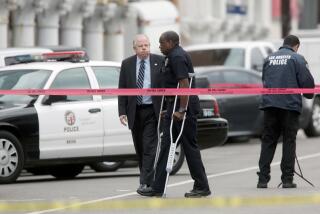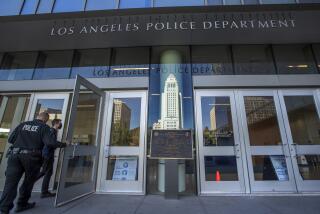San Diego Jury Acquits Officer in Shooting
SAN DIEGO — After deliberating for 10 minutes, a jury Thursday acquitted the only San Diego police officer ever criminally charged for an on-duty shooting.
Jurors asked the judge for a list of the commendations won by Officer Christopher Chaney because they plan to write letters on his behalf to the police chief. Several jurors immediately telephoned the chief to urge that Chaney remain on the force.
“The wrong person was on trial,” juror Terry Rankhorn said after the verdict. “Three guys were loaded and driving like madmen and ramming a police car. If it was me, I’d have shot all three of them.”
Chaney, 34, a five-year veteran, said he holds no malice toward the Police Department and is eager to return to patrol duty. Stripped of his gun, he was assigned to desk duty after being charged with assault with a deadly weapon.
Police Chief Jerry Sanders, who had recommended that Chaney be prosecuted for the Oct. 8 shooting, said he wants to review all the evidence, including that presented by the defense during the trial, before making a decision on whether to fire Chaney.
“If we made a mistake in this investigation, then I’ll say we made a mistake,” Sanders said. But “I’m going to have to be comfortable with the version of events that the jury was comfortable with.”
Chaney took the verdict stoically and then called his wife, who is four months pregnant, to tell her the good news. “I’m relieved,” he said. “This has been going on for seven months, but it seems like forever.”
When the verdict was read, a group of off-duty police officers cheered and clapped.
“We knew from the start Chris was innocent and this trial should never have happened,” said Officer Lorie Glick, who has started a fund to help Chaney pay his legal bills.
Chaney’s defense attorneys, William Braniff and Drew Page of the San Diego office of the Los Angeles-based firm of Latham & Watkins, worked pro bono, but Chaney still must pay for such things as expert witnesses and transcripts. Those costs might surpass $30,000.
Among other things, Braniff and Page had a computer-generated video made to demonstrate to the jury Chaney’s version of events: that after a high-speed, nighttime chase of a battered Camaro, the vehicle rammed his police car, and then one of its occupants ran toward him in a menacing manner.
Antonio Bogarin, 23, who was drunk and driving without a license, was wounded in the back of the arm.
In a two-week trial, Braniff picked apart the prosecution’s case by showing, he said, that police investigators overlooked some evidence, misinterpreted other evidence and failed to pursue some leads.
Braniff, a former federal prosecutor, said he thought that a kind of “political correctness” took over when it first appeared that Chaney was not telling the truth. Investigators became reluctant to believe Chaney for fear it would appear that they were going soft on a fellow officer, Braniff asserted.
“San Diego has a great Police Department,” said Chaney, who took the witness stand to proclaim his innocence. “But every now and then, you’ll find an individual who does things with a narrow focus and doesn’t look at anything that doesn’t fit that focus.”
Investigators did not believe that Chaney’s version was credible because the driver’s door on the Camaro appeared not to open and because Bogarin was 30 feet away from the car when struck by the bullet.
The defense showed that the driver’s door, while broken, could still be opened. Braniff asserted that the man Chaney shot at was not the driver but a felon and drug user named Frank Palisi who charged out of the driver’s door and directly at Chaney. The bullet missed Palisi and struck Bogarin while he attempted to flee, Braniff told jurors.
A police criminologist, called by the prosecution, agreed with Braniff that Chaney’s story was not inconsistent with the evidence at the scene.
Palisi, dressed in prison blues, testified that he went out the passenger’s door and never charged at Chaney. Palisi was on parole when the Oct. 8 chase took place but has since been returned to prison for a theft conviction.
In its 107-year history, back to the days when Wyatt Earp ran a gambling den in downtown San Diego, no other officer in the San Diego Police Department has been charged criminally for an on-duty shooting, although there have been officers convicted of other on-duty offenses such as burglary and roughing up transients.
In 1979, a grand jury refused the district attorney’s request to indict a National City officer for shooting and killing a fleeing suspect. In 1984, a jury acquitted an Escondido officer in the fatal shooting of a hostage taken by a bank robber.
Dist. Atty. Paul Pfingst said the quick verdict did not change his belief that the case against Chaney “was a case that a jury had to decide.” He confirmed, however, that there were people in his office who thought Chaney should not be charged and that he had overruled them.
“I respect the work of the jurors,” Pfingst said. “These are difficult cases. . . . But we are still committed to seeing that police officers do not use excessive force.”
More to Read
Sign up for Essential California
The most important California stories and recommendations in your inbox every morning.
You may occasionally receive promotional content from the Los Angeles Times.









